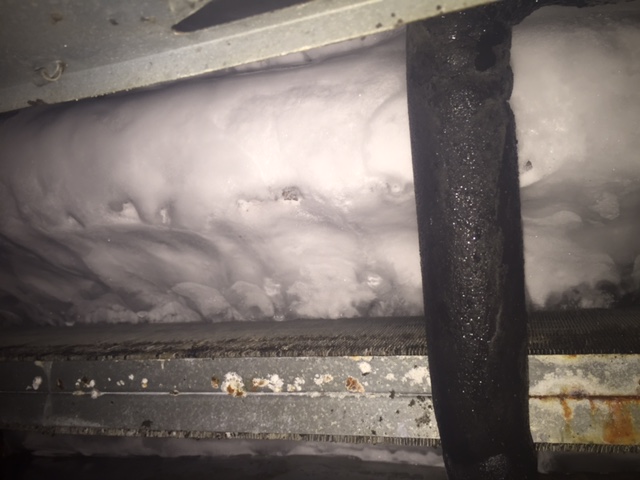Actions to Take If My AC Pipe Is Frozen - Quick Solutions for Thawing
Actions to Take If My AC Pipe Is Frozen - Quick Solutions for Thawing
Blog Article
This post following next pertaining to Why Is Ice On My Outside Air Conditione is extremely compelling. Give it a go and make your own results.

Intro
Finding that your a/c pipeline is frozen can be worrying, specifically throughout hot summer months when you depend on your air conditioning system one of the most. Recognizing what to do in such a scenario is essential to avoid additional damage to your cooling system and ensure your comfort inside.
Understanding the Causes
Several variables can contribute to the cold of an AC pipeline. Recognizing these reasons can assist you attend to the issue efficiently.
Lack of Airflow
One usual cause of an icy air conditioner pipe is inadequate air flow. When the air movement over the evaporator coil is restricted, it can trigger the coil to drop below freezing temperature, bring about ice development on the pipeline.
Low Refrigerant Levels
Inadequate refrigerant degrees in your air conditioner system can additionally result in an icy pipe. Reduced cooling agent levels can create the pressure in the system to go down, leading to the freezing of dampness on the evaporator coil.
Cold Weather Conditions
In cooler climates, freezing temperatures outside can contribute to the cold of air conditioning pipes. If your air conditioning device is not properly shielded or if there are leakages in the ductwork, cold air can infiltrate the system, triggering the pipe to ice up.
Dirty Air Filters
Dirty or clogged up air filters can limit air movement in your AC system, leading to various problems, consisting of an icy pipeline. It's essential to replace or clean your air filters routinely to guarantee correct air flow and avoid ice buildup.
Signs of a Frozen Air Conditioner Pipe
Identifying the indicators of a frozen AC pipeline is important for punctual activity.
Minimized Airflow
If you see a considerable reduction in airflow from your vents, it can suggest an icy pipeline.
Ice Buildup on the Pipe
Visible ice build-up on the cooling agent line or the evaporator coil is a clear indication of an icy AC pipe.
Weird Sounds from the Unit
Uncommon sounds, such as hissing or gurgling, coming from your air conditioner unit can signal that there's ice existing on the pipeline.
Immediate Actions to Take
When faced with an icy air conditioner pipeline, it's vital to act rapidly to prevent more damages to your cooling system.
Turning off the air conditioning
The first step is to turn off your a/c unit to avoid the system from running and exacerbating the problem.
Checking for Blockages
Evaluate the location around the indoor system for any kind of blockages that may be obstructing airflow, such as furnishings or curtains.
Defrosting the Pipe
You can utilize gentle methods like putting towels taken in cozy water around the frozen pipe to help thaw it slowly.
Preventive Measures
Taking safety nets can assist prevent future occurrences of an icy AC pipeline.
Routine Maintenance Checks
Schedule regular maintenance get in touch with a professional HVAC service technician to ensure that your air conditioner system is running successfully.
Altering Air Filters
Regularly change or clean your air filters to stop airflow constraints and keep optimum efficiency.
Insulating Exposed Pipes
If your air conditioning pipes are exposed to cold temperatures, consider protecting them to avoid freezing throughout cold weather.
Seeking Professional Help
If DIY approaches fall short to solve the issue or if you're unsure regarding how to continue, it's ideal to look for assistance from a certified HVAC professional.
When DIY Methods Fail
If your efforts to thaw the pipe or address other problems are not successful, it's time to hire a professional.
Importance of Hiring a Professional HVAC Technician
A certified HVAC service technician has the knowledge and devices required to identify and fix concerns with your air conditioning system safely and properly.
Conclusion
Taking care of an icy air conditioner pipe can be an aggravating experience, but knowing how to respond can assist decrease damage and restore comfort to your home. By understanding the causes, identifying the signs, and taking prompt activity, you can effectively deal with the issue and stop future occurrences.
What to Do If Your AC Line Is Frozen
Make Sure All Supply and Return Air Vents Are Open
If you notice problems with airflow, the first thing you should do is check your supply and return vents. Supply vents distribute clean, conditioned air throughout your home. As this air becomes stale, it’s pulled into the return vent, where it’s reconditioned before being sent back out through the supply vent.
When these vents are closed, air won’t flow in the home. Before examining your AC, check the vents in every room and ensure they’re all open.
Check for a Dirty Air Filter
Another possible cause of limited airflow is a dirty air filter. Your air conditioner’s filters catch elements you don’t want to breathe in, such as dirt and dust. Over time, filters can become clogged, ultimately blocking air from flowing in and out. The lack of airflow can then cause the entire coil to freeze and will completely restrict any air from moving through it. The AC may need to be powered off for one to two days to allow the coil to thaw after replacing the filter to allow proper functioning of the unit. This debris can also accumulate on your AC’s evaporator coil, requiring a more serious repair. In general, air filters should be cleaned regularly (about every two weeks).
Assess Your Outdoor Unit
In addition to checking your AC, assessing the outdoor unit is a good idea. Also known as the condensing unit, it works with your interior unit to release heat outside. An issue with the outdoor unit can result in rising internal temperatures.
Overgrown Shrubs or Clogged Leaves
From leaves and twigs to shrubs and debris, there’s no shortage of outdoor elements that can accumulate around your condensing unit. When these elements get lodged inside the unit, they can block airflow. Fortunately, removing the blockage can solve the problem.
Sounds of a Broken Fan
Shrubs and leaves aren’t the only things that can impede your outdoor unit’s airflow. If the fan is broken, the unit won’t be able to properly get rid of heat — which means the internal temperature won’t go down. First, make sure the fan is spinning. If it is, check for the following sounds of a broken fan:
Buzzing Rattling Screeching Hissing Clicking Preventative Measures
Nobody wants to deal with a frozen AC line. In addition to causing problems with your air conditioner, they require professional repairs. On the bright side, there are preventative measures you can take to help ensure this issue doesn’t arise in the first place.
https://www.coopergreenteam.com/blog/what-to-do-if-ac-line-frozen

As a passionate reader about What Causes AC Pipes To Freeze?, I think sharing that piece of content was worth the trouble. For those who liked our post please don't forget to share it. Thanks a lot for taking the time to read it.
Schedule An Appointment Report this page